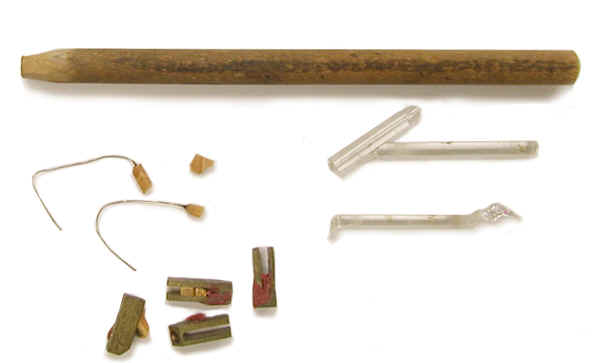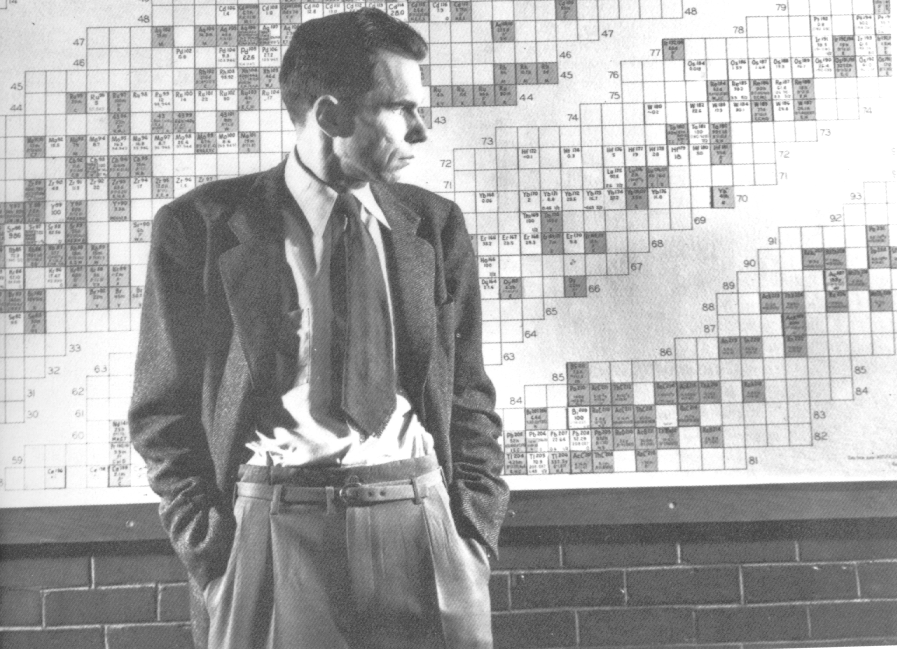Glenn Seaborg and John Livingood—Items for Electroscope Manufacture (1936-1938)
These items were donated by Glenn Seaborg and identified by him as items that he and John Livingood had used at the University of California in Berkeley while they were collaborating together. This would have been between 1936 and 1938 (in late 1938 Livingood moved to Massachusetts). The small cardboard box which contained everything except the wooden dowel, had the following written on it in Livingood's handwriting: "Amber insulator, [unreadable] frames, quartz rods."

Quoting some of Seaborg's presentation at the 1970 annual meeting of the Society of Nuclear Medicine "The chemical work I performed during my continuing collaboration with Jack while he was still in Berkeley was all done in this little corner of the room in LeConte Hall. Our teamwork in every instance consisted of Jack's performing the cyclotron bombardments, after which I dissolved the target material and made the chemical separations. We next mounted the chemical end products on cardboard sheets and covered these with thin cellophane. He then measured their radiation characteristics, using a small Lauritsen quartz fiber electroscope mounted in a sort of cubbyhole room in the basement at the opposite end of LeConte Hall. Jack constructed and operated the quartz fiber electroscope with consummate skill. As our work progressed the measurements all tended to be made on one electroscope."
The three quartz rods seen in the photo (ca. 1 to 2" long) would have been used to produce the fibers for the electroscope. This involved heating up a section of the quartz rod and drawing it out until it was very thin (several micrometers in diameter). The ends of the lowermost of the three quartz rods in the photo show clear evidence of having been heated. Livingood could have used any one of a number of ways to draw out the quartz, but no matter which method was chosen, it required skill and patience.
The small orange-brown objects are bits of amber. Two of these have the ends of a short piece of wire embedded in them. Amber was commonly used in the construction of insulators, not just for electroscopes but for a wide variety of nuclear instruments. Although it is not obvious in the photograph, a tiny blade was embedded in the left end of the wooden dowel seen towards the top of the photo. It would have been used to carve the amber, but it might also have been used to cut the quartz fibers into sections. Some handwriting on a small piece of paper that came with it reads "knife for trimming amber."
I am far less certain of how the four small (5/8" long) brass "frames" were used. Two of the frames hold bits of amber. This might indicate that they were used to hold the amber while it was being worked on. Each frame has a tiny hole drilled through the base and this might have been used to help position the metal wires. Each of the brass frames also has a bit of red wax attached to it.
Two quartz fiber electroscopes built by Art Snell at Berkeley during this period (1937, 1938) can be seen by clicking here.
Donated by Glenn Seaborg.
References
- Glenn Seaborg, personal communication.
- Glen Seaborg. Remarks by Dr. Glenn T. Seaborg, Chairman U.S. Atomic Energy Commission at the 17th Annual Meeting of the Society of Nuclear Medicine Washington, D.C. July 10, 1970. "Reminiscences on the Development of Some Medically Useful Radionuclides."

Glenn Seaborg
